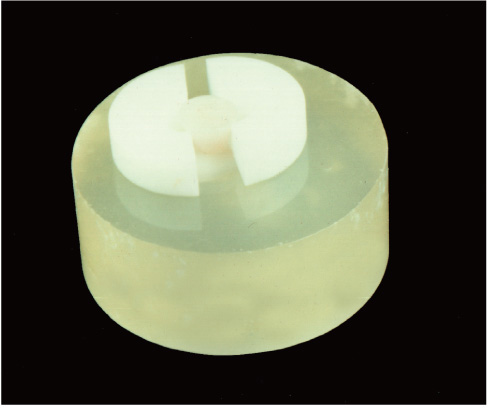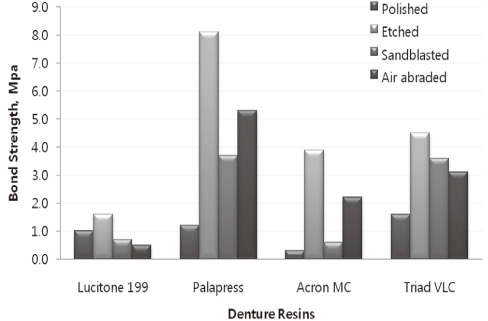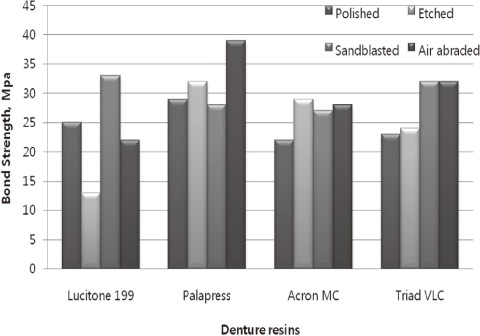J Adv Prosthodont.
2013 Nov;5(4):423-427. 10.4047/jap.2013.5.4.423.
Tensile bond strength of four denture resins to porcelain teeth with different surface treatment
- Affiliations
-
- 1Department of Prosthodontics, Faculty of dentistry, Tanta University, Tanta, Egypt. melsheikh@yahoo.com
- 2Houston Biomaterials Research Center, University of Texas-Houston Dental Branch, Houston, TX, USA.
- KMID: 2176533
- DOI: http://doi.org/10.4047/jap.2013.5.4.423
Abstract
- PURPOSE
This study evaluated the bond strength between porcelain denture teeth (Bioblend 43D) and four different polymerized denture resins (Lucitone 199, Palapress, Acron MC, Triad) with and without a bonding agent and after four different types of surface treatment (polished, HF etched, sandblasted, air-abraded).
MATERIALS AND METHODS
Central incisor porcelain denture teeth were divided into 32 groups of 5 each. Tensile bond strength (MPa) was determined using a testing machine at crosshead speed of 0.5 mm/min. Mean and standard deviation are listed. Data were analyzed by two-way ANOVA. Means were compared by Tukey-Kramer intervals at 0.05 significance level.
RESULTS
All surface treatment increased bond strength compared to polished surface and the highest bond strength was found with Palapress resin with etched porcelain surface (8.1 MPa). Bonding agent improved the bond strength of all denture resins to porcelain teeth. Superior bonding was found with Palapress and air-abraded porcelain (39 MPa).
CONCLUSION
Resins with different curing methods affect the bond strength of porcelain teeth to denture bases. Superior bonding was found with auto-polymerized resin (Palapress). Application of ceramic primer and bonding agent to porcelain teeth with and without surface treatment will improve the bond strength of all denture resins to porcelain teeth.
MeSH Terms
Figure
Reference
-
1. Büyükyilmaz S, Ruyter IE. The effects of polymerization temperature on the acrylic resin denture base-tooth bond. Int J Prosthodont. 1997; 10:49–54.2. Takahashi Y, Chai J, Takahashi T, Habu T. Bond strength of denture teeth to denture base resins. Int J Prosthodont. 2000; 13:59–65.3. El-Sheikh MM, Powers JM. Tensile bond strength of porcelain teeth to denture resin before and after aging. Int J Prosthodont. 1998; 11:16–20.4. Craig RG. Prosthetic appliance of polymers. Restorative Dental Materials. 11th ed. St Louis: Mosby;2002. p. 570–571.5. Spohr AM, Sobrinho LC, Consani S, Sinhoreti MA, Knowles JC. Influence of surface conditions and silane agent on the bond of resin to IPS Empress 2 ceramic. Int J Prosthodont. 2003; 16:277–282.6. Filho AM, Vieira LC, Araújo E, Monteiro Júnior S. Effect of different ceramic surface treatments on resin microtensile bond strength. J Prosthodont. 2004; 13:28–35.7. Roulet JF, Söderholm KJ, Longmate J. Effects of treatment and storage conditions on ceramic/composite bond strength. J Dent Res. 1995; 74:381–387.8. Kato H, Matsumura H, Atsuta M. Effect of etching and sandblasting on bond strength to sintered porcelain of unfilled resin. J Oral Rehabil. 2000; 27:103–110.9. Yunus N, Harrison A, Huggett R. Effect of microwave irradiation on the flexural strength and residual monomer levels of an acrylic resin repair material. J Oral Rehabil. 1994; 21:641–648.10. Schneider RL, Curtis ER, Clancy JM. Tensile bond strength of acrylic resin denture teeth to a microwave-or heat-processed denture base. J Prosthet Dent. 2002; 88:145–150.11. Cunningham JL. Shear bond strength of resin teeth to heat-cured and light-cured denture base resin. J Oral Rehabil. 2000; 27:312–316.12. Clancy JM, Hawkins LF, Keller JC, Boyer DB. Bond strength and failure analysis of light-cured denture resins bonded to denture teeth. J Prosthet Dent. 1991; 65:315–324.13. Jardel V, Degrange M, Picard B, Derrien G. Correlation of topography to bond strength of etched ceramic. Int J Prosthodont. 1999; 12:59–64.14. Ozcan M. A practical method for chairside repair of debonded porcelain denture teeth. J Prosthodont. 2006; 15:47–50.15. Panah FG, Rezai SM, Ahmadian L. The influence of ceramic surface treatments on the micro-shear bond strength of composite resin to IPS Empress 2. J Prosthodont. 2008; 17:409–414.16. Wegner SM, Kern M. Long-term resin bond strength to zirconia ceramic. J Adhes Dent. 2000; 2:139–147.17. Marchack BW, Yu Z, Zhao XY, White SN. Adhesion of denture tooth porcelain to heat-polymerized denture resin. J Prosthet Dent. 1995; 74:242–249.
- Full Text Links
- Actions
-
Cited
- CITED
-
- Close
- Share
- Similar articles
-
- BOND STRENGTH OF VARIOUS RESINS TO DENTURE TEETH BY SURFACE TREATMENT
- Effect of surface treatment of porcelain on tensile bond strength
- Shear Bond Strengths between Abrasion-Resistant Denture Teeth and Composite Resins
- THE SHEAR BOND STRENGTH OF RESIN TEETH TO THE DENTURE BASE RESIN
- Effect Of Surface Treatments On The Bond Strength Of Denture Base Resins To Dental Alloy





